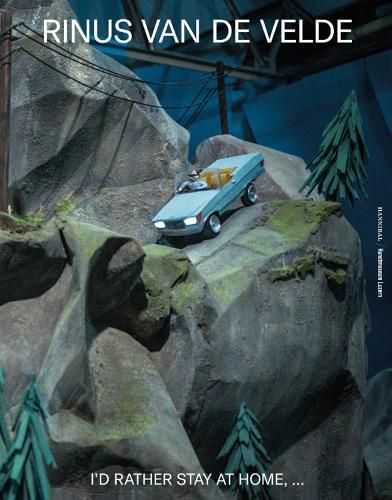Readings Newsletter
Become a Readings Member to make your shopping experience even easier.
Sign in or sign up for free!
You’re not far away from qualifying for FREE standard shipping within Australia
You’ve qualified for FREE standard shipping within Australia
The cart is loading…






Rinus Van de Velde has made remarkable strides in recent years in the development of his oeuvre. Best known for his large-scale charcoal drawings at the start of his career, he now positions himself as a total artist, using a range of different media and forms of expression such as drawing, sculpture, installations and film. Initially, Van de Velde used found photographs and images as a basis for his drawings, but he later went in search of ways of exercising more control over the images. He achieved this through an extensive process of scene-building, in which he cast himself and those around him in different roles and characters in order to fit them into the narrative discourse of his fictional autobiography. These scenes were built up life-size, with even the tiniest detail being reproduced in wood and cardboard. This book focuses on this part of his artistic activity and has been produced to mark the eponymous solo show in Kunstmuseum Luzern in Switzerland. With a textual contribution from Fanni Fetzer and Koen Sels. Text in English and German.
AUTHOR: Rinus Van de Velde (born 1983) lives and works in Antwerp. His practice mainly consists of drawings that hearken back to a personal archive of photographs derived from vulgarising scientific magazines such as National Geographic, from biographies of artists and scientists… Lately, he often re-enacts found footage or even stages non-existent scenes in photographs, which he then uses as source material. Van de Velde’s overtly narrative drawings are confronted with texts in installations that tell a new and personal story. This fiction takes place in a mirror universe that is peopled by courageous alter egos and who serve as ideal representatives of the actual artist. At the same time, this drawn world is delineated by its own subjectivity: it can be nothing but a fantasy, a fiction, and so beyond its borders lies the great nothingness of the real world. 135 colour, 15 b/w illustrations
$9.00 standard shipping within Australia
FREE standard shipping within Australia for orders over $100.00
Express & International shipping calculated at checkout
Rinus Van de Velde has made remarkable strides in recent years in the development of his oeuvre. Best known for his large-scale charcoal drawings at the start of his career, he now positions himself as a total artist, using a range of different media and forms of expression such as drawing, sculpture, installations and film. Initially, Van de Velde used found photographs and images as a basis for his drawings, but he later went in search of ways of exercising more control over the images. He achieved this through an extensive process of scene-building, in which he cast himself and those around him in different roles and characters in order to fit them into the narrative discourse of his fictional autobiography. These scenes were built up life-size, with even the tiniest detail being reproduced in wood and cardboard. This book focuses on this part of his artistic activity and has been produced to mark the eponymous solo show in Kunstmuseum Luzern in Switzerland. With a textual contribution from Fanni Fetzer and Koen Sels. Text in English and German.
AUTHOR: Rinus Van de Velde (born 1983) lives and works in Antwerp. His practice mainly consists of drawings that hearken back to a personal archive of photographs derived from vulgarising scientific magazines such as National Geographic, from biographies of artists and scientists… Lately, he often re-enacts found footage or even stages non-existent scenes in photographs, which he then uses as source material. Van de Velde’s overtly narrative drawings are confronted with texts in installations that tell a new and personal story. This fiction takes place in a mirror universe that is peopled by courageous alter egos and who serve as ideal representatives of the actual artist. At the same time, this drawn world is delineated by its own subjectivity: it can be nothing but a fantasy, a fiction, and so beyond its borders lies the great nothingness of the real world. 135 colour, 15 b/w illustrations